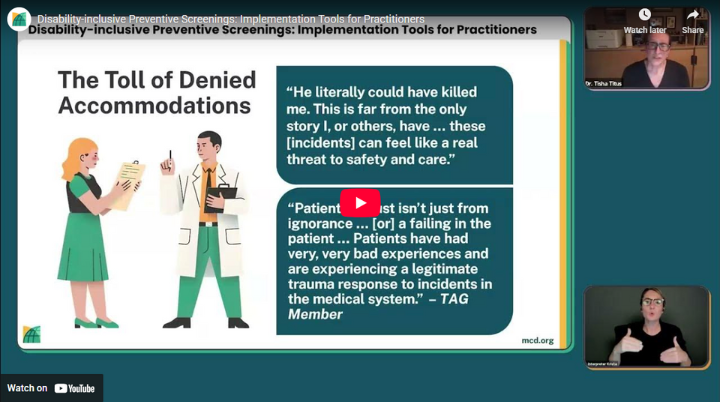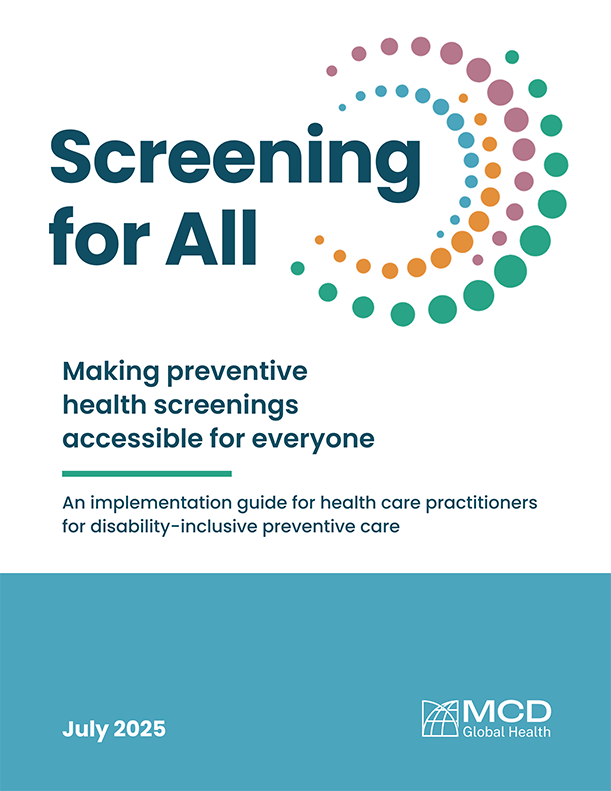Small changes in your practice can dramatically improve care for all your patients.
One in four of your patients has a disability. When standard procedures do not meet their needs, the default response is often: "We can't do that." But, the real response should be, "How can we do this differently?”
Below are resources to help you provide better preventive screenings for patients with disabilities:

Free CME Webinar
This webinar provides health care practitioners with evidence-based tools and a structured implementation approach to make preventive health screenings accessible for patients with disabilities. Participants learn to identify common accessibility barriers, implement specific accommodations for USPSTF A/B recommended screenings, and develop practical plans for improving screening accessibility. The session features a patient with disabilities as a co-presenter, sharing real experiences with breast, cervical, colorectal, and osteoporosis screenings, demonstrating the importance of collaborative planning and disability-inclusive care approaches.
For CME credit, go to MCD Learn and set up a free account, view the webinar recording, and complete the evaluation for 1.0 CME credit.
View Recording MCD Learn for CME CreditDon’t need the CME credit? Watch the webinar recording on YouTube.
View Recording on YouTubeImplementation Guide
A step-by-step plan for implementing accessibility improvements at your practice.
The implementation guide provides a structured approach to make your practice more accessible and improve preventive screening rates for patients with disabilities.
What is Inside?
- Data summary: Evidence showing the scope of health disparities and screening gaps for people with disabilities for USPSTF A/B recommended preventive screenings.
- Adjustments and adaptation summary: Evidence-based modifications to improve accessibility and quality of preventive screenings.
- Implementation plan: A phased approach organized into manageable steps over 18-24 months.
- Practical Resources: Clinical guidance and tools for office staff, including Practice Considerations and Office Staff Resources.
Practice Considerations and Quick Reference Guides
Evidence-based considerations for patients with disabilities, including alternative screening options, positioning accommodations, and disability-specific risk factors.
Providing effective preventive screenings for patients with disabilities requires understanding of both standard protocols and evidence-based modifications. These resources provide comprehensive clinical guidance alongside quick reference tools that you can use during patient visits.
How to Use These Resources
For Comprehensive Planning: Practice Considerations
Use the detailed Practice Considerations to understand the full scope of accommodations and clinical decision points for each screening. These guides cover patient assessment, disability-specific clinical considerations, and alternative screening options:
For Point-of-Care Support: Quick Reference Guides
Use the Quick Reference Guides during patient visits. These two-page summaries highlight the most critical accommodations and considerations for patients with sensory, mobility, and intellectual/developmental disabilities:
For Administering Questionnaires
Use these guidelines when administering any screening questionnaires (mental health, substance use, intimate partner violence, and sexual health). This resource addresses creating inclusive environments, building patient trust, and ensuring appropriate follow-up:
Office Staff Resources
Practical tools to help you start implementing accessibility changes at your practice.
Front desk and office staff are the first points of contact for patients with disabilities. These resources help your team create welcoming, accessible experiences that set the stage for successful preventive care visits.
Tools You Can Use
Learning Resources for Office Staff on Disability-competent Care
Better patient care begins with competence in disability awareness, accessible communication, and universal design, as well as awareness of internal biases. Once foundational soft skills are established, focus shifts to the technical side—establishing workflows that ensure accommodations are consistently provided.
View Curated Learning ResourcesIntake Form Technical Guidelines
This guide helps you create patient intake forms that work for everyone, including patients with disabilities. Traditional intake forms often create barriers for patients with vision, mobility, cognitive, or communication disabilities. Accessible forms reduce appointment delays, improve data quality, and demonstrate your commitment to serving all patients.
View Intake Form Technical Guidelines“Ask About Accommodations” Front Desk Sign
This sign invites patients into a dialogue about accommodations your practice could provide. Please do not post the sign until your practice has completed steps 1.1–2.9 of the Implementation Plan. This will ensure staff are fully prepared to communicate available accommodations, and that systems and staff are in place to document and fulfill requests. By posting this sign, your practice is making a public commitment to accessible care.
Download "Ask About Accommodations" SignThis website is supported by the U.S. CDC of the U.S. Department of Health and Human Services (HHS) as part of a financial assistance award totaling $499,809 with 100% funded by CDC/HHS. The contents are those of the author(s) and do not necessarily represent the official views of, nor an endorsement, by CDC/HHS, or the U.S. Government.
